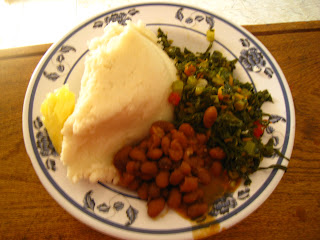I thought I was well and truly beaten trying to find cakes in Tanzania. The food is no frills here, with maize again as a staple part of the diet. However digging a bit deeper I found that the Tanzanians do indeed have a sweet tooth, loving their sodas and chocolate bars!!
Ugali
The staple food of Tanzania is Ugali is an East African dish of maize flour cooked with water to a porridge or dough like consistency. Whilst we were volunteering at the orphanage we had many HUGE plates of Ugali. It's not the tastiest of dishes, but served with some greens like spinach, and sometimes beans, it's a bit of an improvement.
There's quite a knack to eating it, first trying to pull off a lump of the ugali from the steaming hot mass on your plate (Always with your right hand) and rolling it into a ball, then scooping up a bit of the vegetables to add a bit of flavour.
 |
| Making the ugali - takes a good few hours!! |
 |
| A tasty lunch at the orphanage |
 |
| Ugali with vegetables and beans |
Ugali (The most common food in Tanzania...eaten in most households daily.)
- Maize (White Corn Flour) about 2 cups
- Water
- Salt (Optional)
- One also needs a Mwiko (a large wooden spoon/ladle)
Bring water in a pan to a boil (about 4 Cups)
Reduce heat to medium and put flour, gradually stirring until the consistency is stiff. Stir continuously, and cover for about 5 minutes.
Stir again and form into a mound. The ugali will be done when it pulls from the sides of the pan easily and does not stick. The finished product should look like stiff grits
Cover the pot with a plate and invert the pan so that the Ugali "drops" on the plate.
Serve with meat stew or brown beans.
Mince & Tatties
After receiving many lunches of ugali from Matron at the orphanage, I wanted to make them some scottish food, so what better than a plate of mince and tatties!! It took hours to prepare and cook on the kerosene stove! Maybe not as tasty as my Mum's but they did come back for seconds!!















































